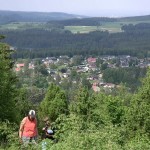Forestry is moving out of the country and into the cities.
Español (pdf) Français (pdf) Deutsch (pdf)
“More than half the world’s population now lives in cities and towns and more forests are coming under urban influence. As foresters we’d better make sure we’re prepared to work in urban settings,” says Professor Cecil Konijnendijk of the University of Copenhagen.
Urban forests, in addition to making cities more attractive, promote human health and well-being, sequester carbon, filter pollutants from the air, provide shade, reduce wind and flooding, improve urban microclimates and protect urban drinking water resources.
“Urban forests and trees are part of the solution to some of the big issues of the day,” he says. “Think climate change, where urban vegetation can help cities adapt to higher temperatures, freak weather occurrences and the like; or trees producing food to help ease shortages in some developing countries.
“But,” says Professor Konijnendijk, who will coordinate a session on promoting urban forest partnerships between scientists and communities at the 2010 IUFRO World Forestry Congress in Seoul, “we still lack knowledge about how trees grow in urban settings and what their optimum contributions are or can be in terms of the goods and services they provide.
“We need to find how to protect, design and develop them in a better way. We, as scientists, have to collaborate closely with those who plan and manage our urban forests,” he says.





Leave a Reply